Business Administration Report: Detailed Analysis of Key Units
VerifiedAdded on 2020/06/04
|26
|6428
|288
Report
AI Summary
This report provides a detailed exploration of various units within business administration. It commences with an introduction to the field, followed by an in-depth analysis of office management procedures, including requirements for implementation, effectiveness, and strategic thinking. The report delves into topics such as work environment, equipment maintenance, performance evaluation systems, supplier relationships, and standard operating procedures. It further examines mail handling processes, including incoming and outgoing mail management, screening procedures, and junk email filtering. The report also addresses employee relations, covering topics like employee assets, career paths, work-related stress, ethical professional practice, and industrial relations. Overall, the report offers comprehensive insights into the core components of business administration, providing a structured understanding of key operational and strategic aspects.
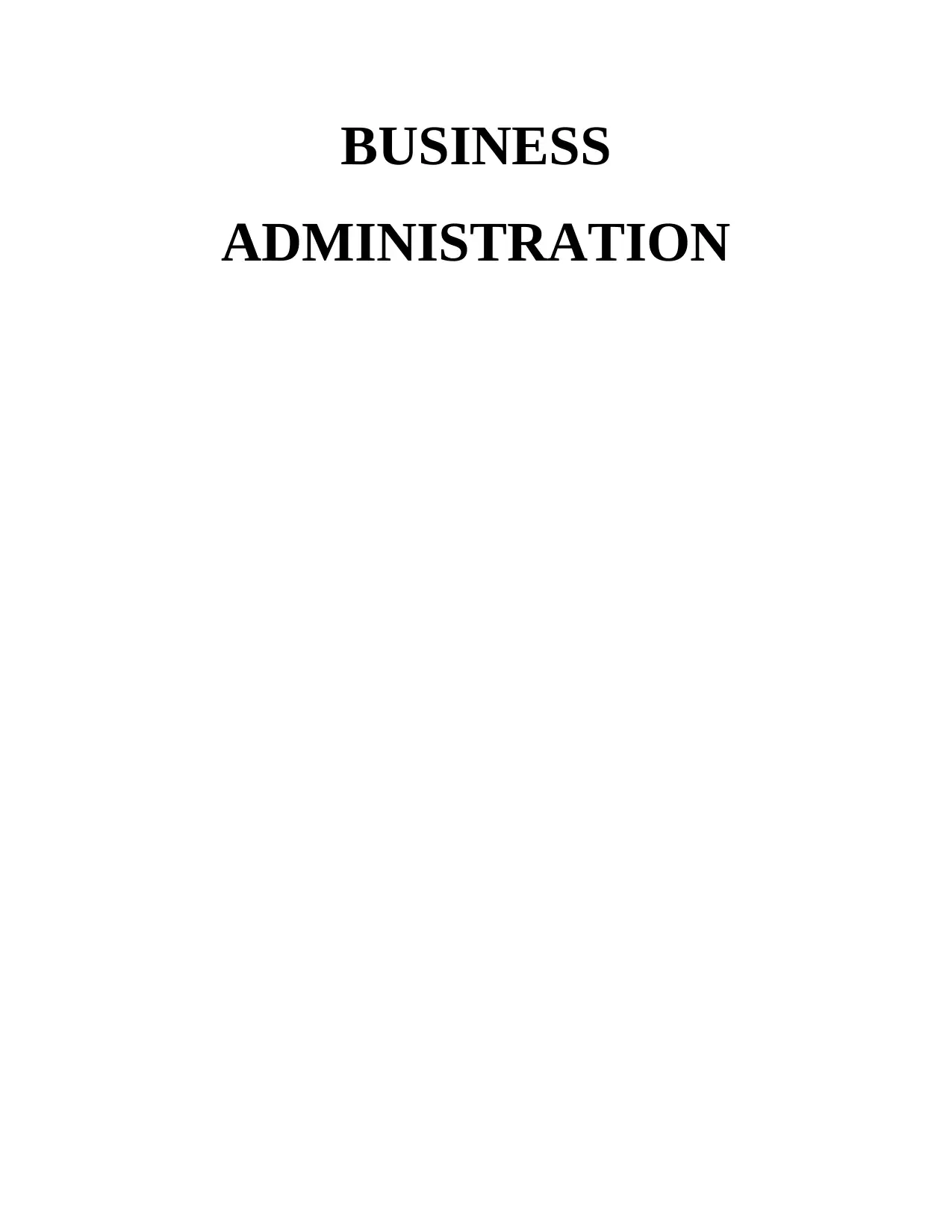
BUSINESS
ADMINISTRATION
ADMINISTRATION
Paraphrase This Document
Need a fresh take? Get an instant paraphrase of this document with our AI Paraphraser
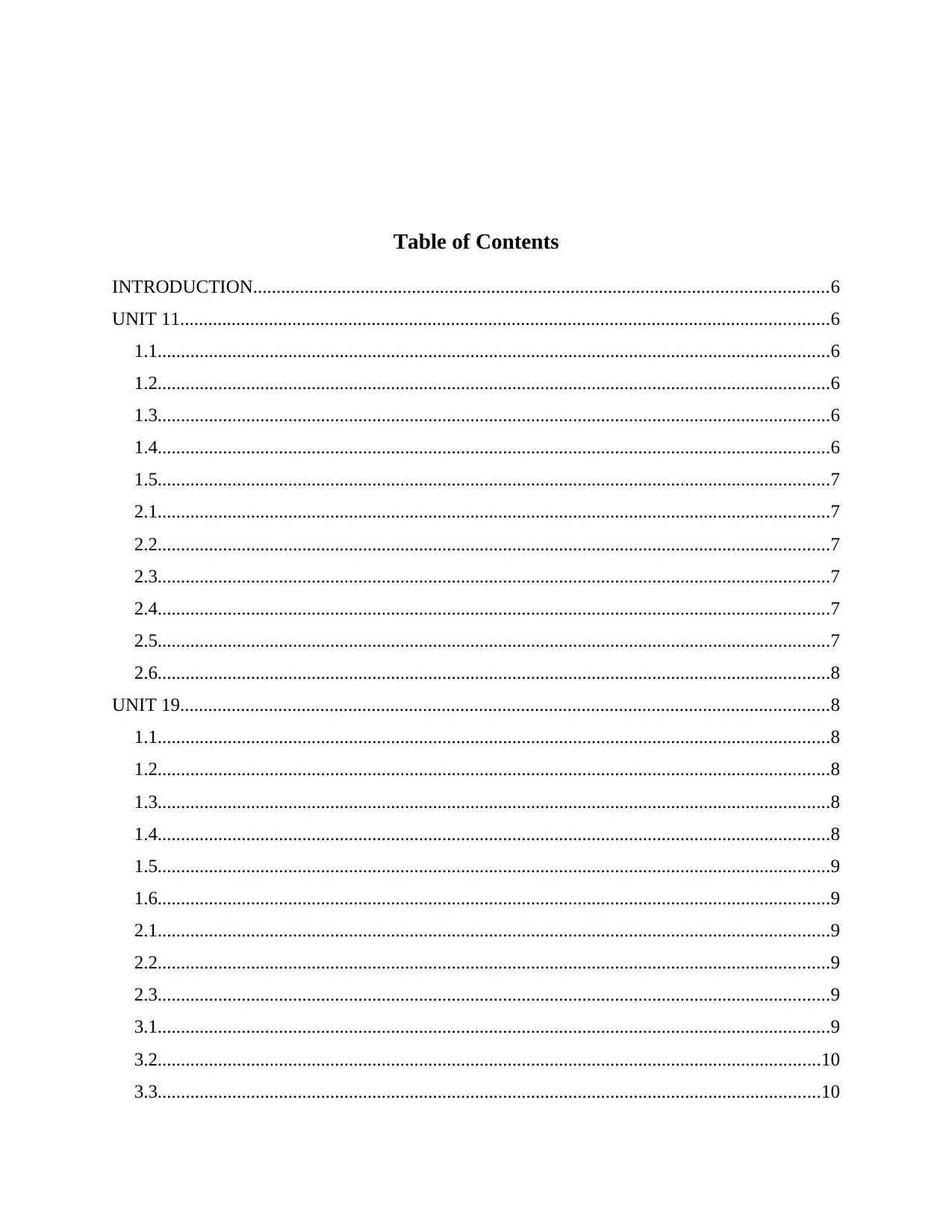
Table of Contents
INTRODUCTION...........................................................................................................................6
UNIT 11...........................................................................................................................................6
1.1................................................................................................................................................6
1.2................................................................................................................................................6
1.3................................................................................................................................................6
1.4................................................................................................................................................6
1.5................................................................................................................................................7
2.1................................................................................................................................................7
2.2................................................................................................................................................7
2.3................................................................................................................................................7
2.4................................................................................................................................................7
2.5................................................................................................................................................7
2.6................................................................................................................................................8
UNIT 19...........................................................................................................................................8
1.1................................................................................................................................................8
1.2................................................................................................................................................8
1.3................................................................................................................................................8
1.4................................................................................................................................................8
1.5................................................................................................................................................9
1.6................................................................................................................................................9
2.1................................................................................................................................................9
2.2................................................................................................................................................9
2.3................................................................................................................................................9
3.1................................................................................................................................................9
3.2..............................................................................................................................................10
3.3..............................................................................................................................................10
INTRODUCTION...........................................................................................................................6
UNIT 11...........................................................................................................................................6
1.1................................................................................................................................................6
1.2................................................................................................................................................6
1.3................................................................................................................................................6
1.4................................................................................................................................................6
1.5................................................................................................................................................7
2.1................................................................................................................................................7
2.2................................................................................................................................................7
2.3................................................................................................................................................7
2.4................................................................................................................................................7
2.5................................................................................................................................................7
2.6................................................................................................................................................8
UNIT 19...........................................................................................................................................8
1.1................................................................................................................................................8
1.2................................................................................................................................................8
1.3................................................................................................................................................8
1.4................................................................................................................................................8
1.5................................................................................................................................................9
1.6................................................................................................................................................9
2.1................................................................................................................................................9
2.2................................................................................................................................................9
2.3................................................................................................................................................9
3.1................................................................................................................................................9
3.2..............................................................................................................................................10
3.3..............................................................................................................................................10
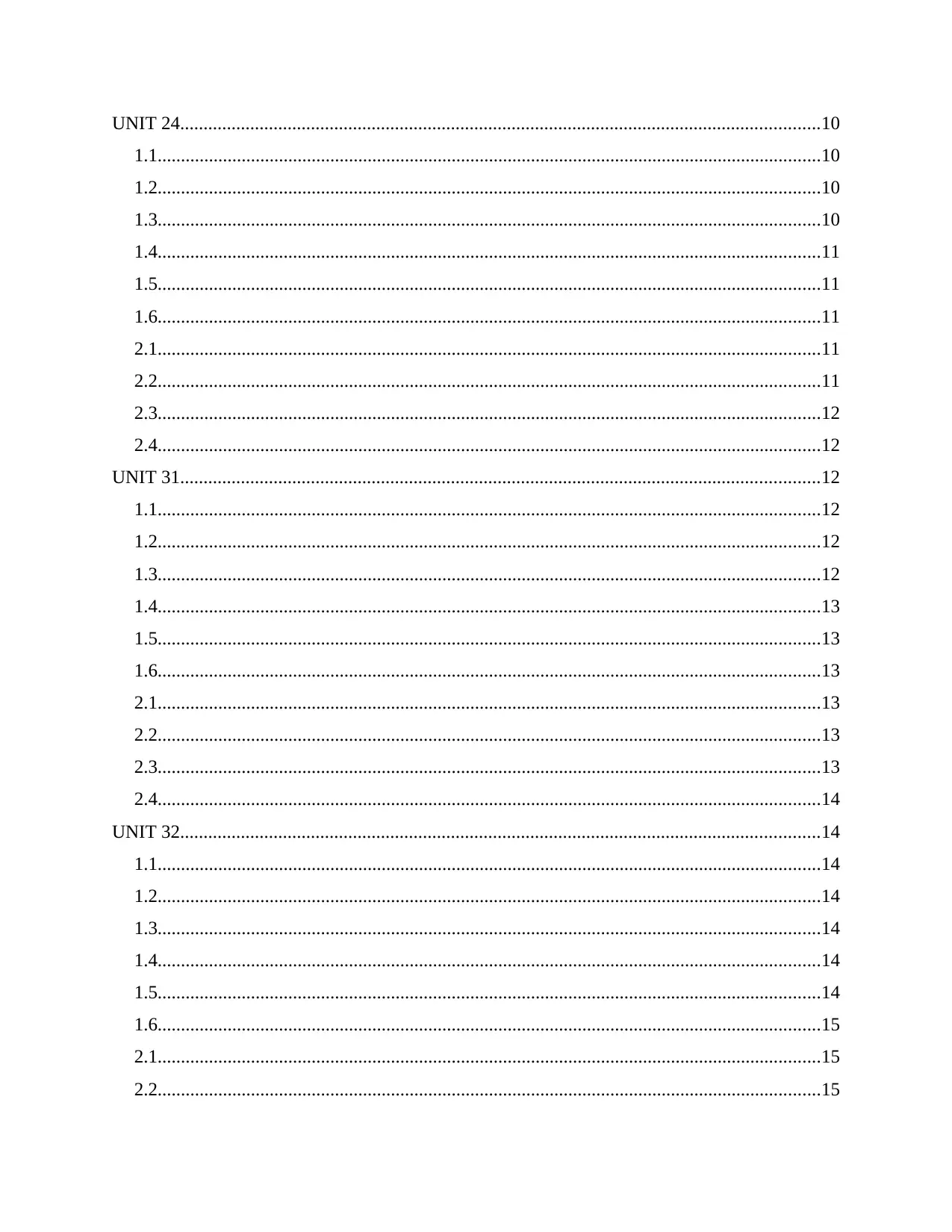
UNIT 24.........................................................................................................................................10
1.1..............................................................................................................................................10
1.2..............................................................................................................................................10
1.3..............................................................................................................................................10
1.4..............................................................................................................................................11
1.5..............................................................................................................................................11
1.6..............................................................................................................................................11
2.1..............................................................................................................................................11
2.2..............................................................................................................................................11
2.3..............................................................................................................................................12
2.4..............................................................................................................................................12
UNIT 31.........................................................................................................................................12
1.1..............................................................................................................................................12
1.2..............................................................................................................................................12
1.3..............................................................................................................................................12
1.4..............................................................................................................................................13
1.5..............................................................................................................................................13
1.6..............................................................................................................................................13
2.1..............................................................................................................................................13
2.2..............................................................................................................................................13
2.3..............................................................................................................................................13
2.4..............................................................................................................................................14
UNIT 32.........................................................................................................................................14
1.1..............................................................................................................................................14
1.2..............................................................................................................................................14
1.3..............................................................................................................................................14
1.4..............................................................................................................................................14
1.5..............................................................................................................................................14
1.6..............................................................................................................................................15
2.1..............................................................................................................................................15
2.2..............................................................................................................................................15
1.1..............................................................................................................................................10
1.2..............................................................................................................................................10
1.3..............................................................................................................................................10
1.4..............................................................................................................................................11
1.5..............................................................................................................................................11
1.6..............................................................................................................................................11
2.1..............................................................................................................................................11
2.2..............................................................................................................................................11
2.3..............................................................................................................................................12
2.4..............................................................................................................................................12
UNIT 31.........................................................................................................................................12
1.1..............................................................................................................................................12
1.2..............................................................................................................................................12
1.3..............................................................................................................................................12
1.4..............................................................................................................................................13
1.5..............................................................................................................................................13
1.6..............................................................................................................................................13
2.1..............................................................................................................................................13
2.2..............................................................................................................................................13
2.3..............................................................................................................................................13
2.4..............................................................................................................................................14
UNIT 32.........................................................................................................................................14
1.1..............................................................................................................................................14
1.2..............................................................................................................................................14
1.3..............................................................................................................................................14
1.4..............................................................................................................................................14
1.5..............................................................................................................................................14
1.6..............................................................................................................................................15
2.1..............................................................................................................................................15
2.2..............................................................................................................................................15
⊘ This is a preview!⊘
Do you want full access?
Subscribe today to unlock all pages.

Trusted by 1+ million students worldwide
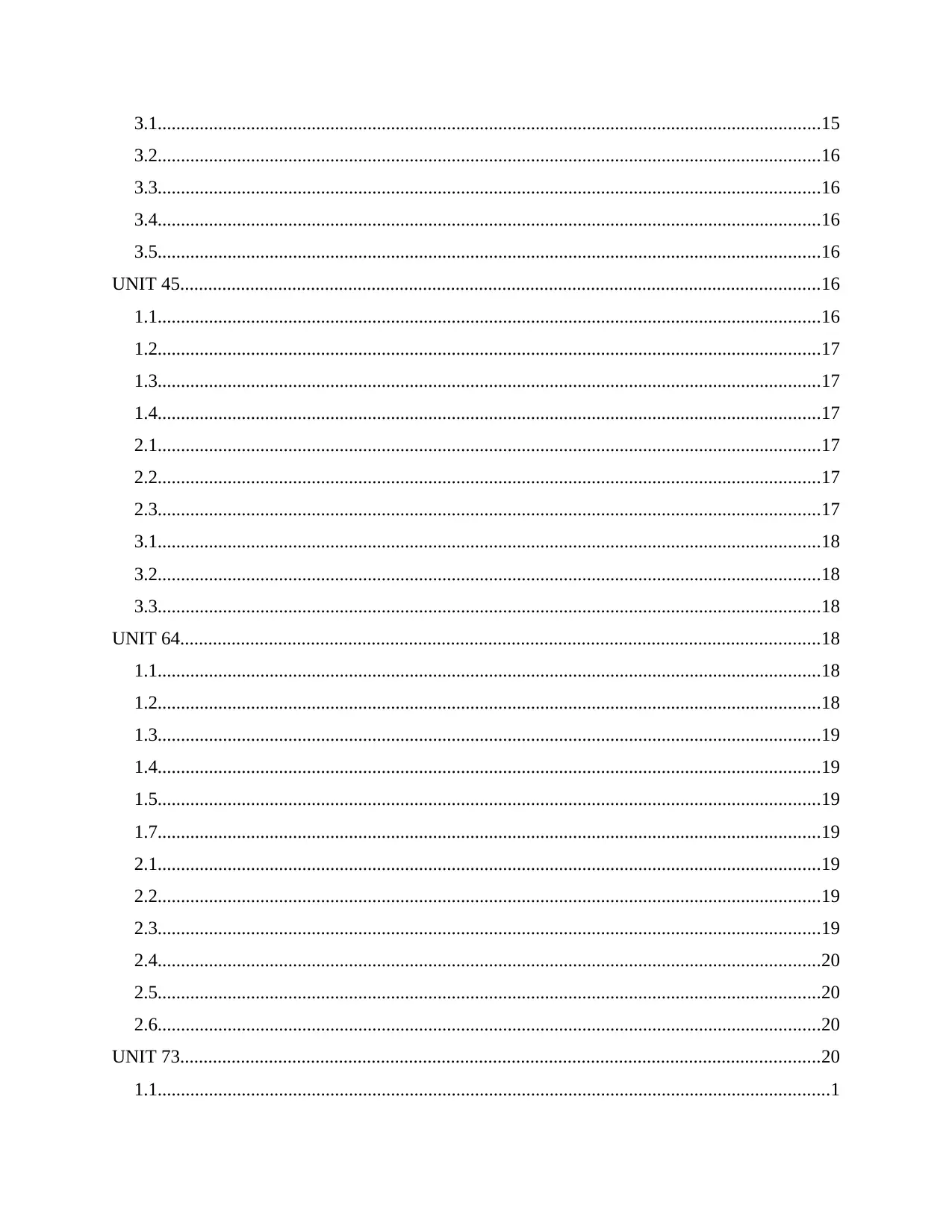
3.1..............................................................................................................................................15
3.2..............................................................................................................................................16
3.3..............................................................................................................................................16
3.4..............................................................................................................................................16
3.5..............................................................................................................................................16
UNIT 45.........................................................................................................................................16
1.1..............................................................................................................................................16
1.2..............................................................................................................................................17
1.3..............................................................................................................................................17
1.4..............................................................................................................................................17
2.1..............................................................................................................................................17
2.2..............................................................................................................................................17
2.3..............................................................................................................................................17
3.1..............................................................................................................................................18
3.2..............................................................................................................................................18
3.3..............................................................................................................................................18
UNIT 64.........................................................................................................................................18
1.1..............................................................................................................................................18
1.2..............................................................................................................................................18
1.3..............................................................................................................................................19
1.4..............................................................................................................................................19
1.5..............................................................................................................................................19
1.7..............................................................................................................................................19
2.1..............................................................................................................................................19
2.2..............................................................................................................................................19
2.3..............................................................................................................................................19
2.4..............................................................................................................................................20
2.5..............................................................................................................................................20
2.6..............................................................................................................................................20
UNIT 73.........................................................................................................................................20
1.1................................................................................................................................................1
3.2..............................................................................................................................................16
3.3..............................................................................................................................................16
3.4..............................................................................................................................................16
3.5..............................................................................................................................................16
UNIT 45.........................................................................................................................................16
1.1..............................................................................................................................................16
1.2..............................................................................................................................................17
1.3..............................................................................................................................................17
1.4..............................................................................................................................................17
2.1..............................................................................................................................................17
2.2..............................................................................................................................................17
2.3..............................................................................................................................................17
3.1..............................................................................................................................................18
3.2..............................................................................................................................................18
3.3..............................................................................................................................................18
UNIT 64.........................................................................................................................................18
1.1..............................................................................................................................................18
1.2..............................................................................................................................................18
1.3..............................................................................................................................................19
1.4..............................................................................................................................................19
1.5..............................................................................................................................................19
1.7..............................................................................................................................................19
2.1..............................................................................................................................................19
2.2..............................................................................................................................................19
2.3..............................................................................................................................................19
2.4..............................................................................................................................................20
2.5..............................................................................................................................................20
2.6..............................................................................................................................................20
UNIT 73.........................................................................................................................................20
1.1................................................................................................................................................1
Paraphrase This Document
Need a fresh take? Get an instant paraphrase of this document with our AI Paraphraser
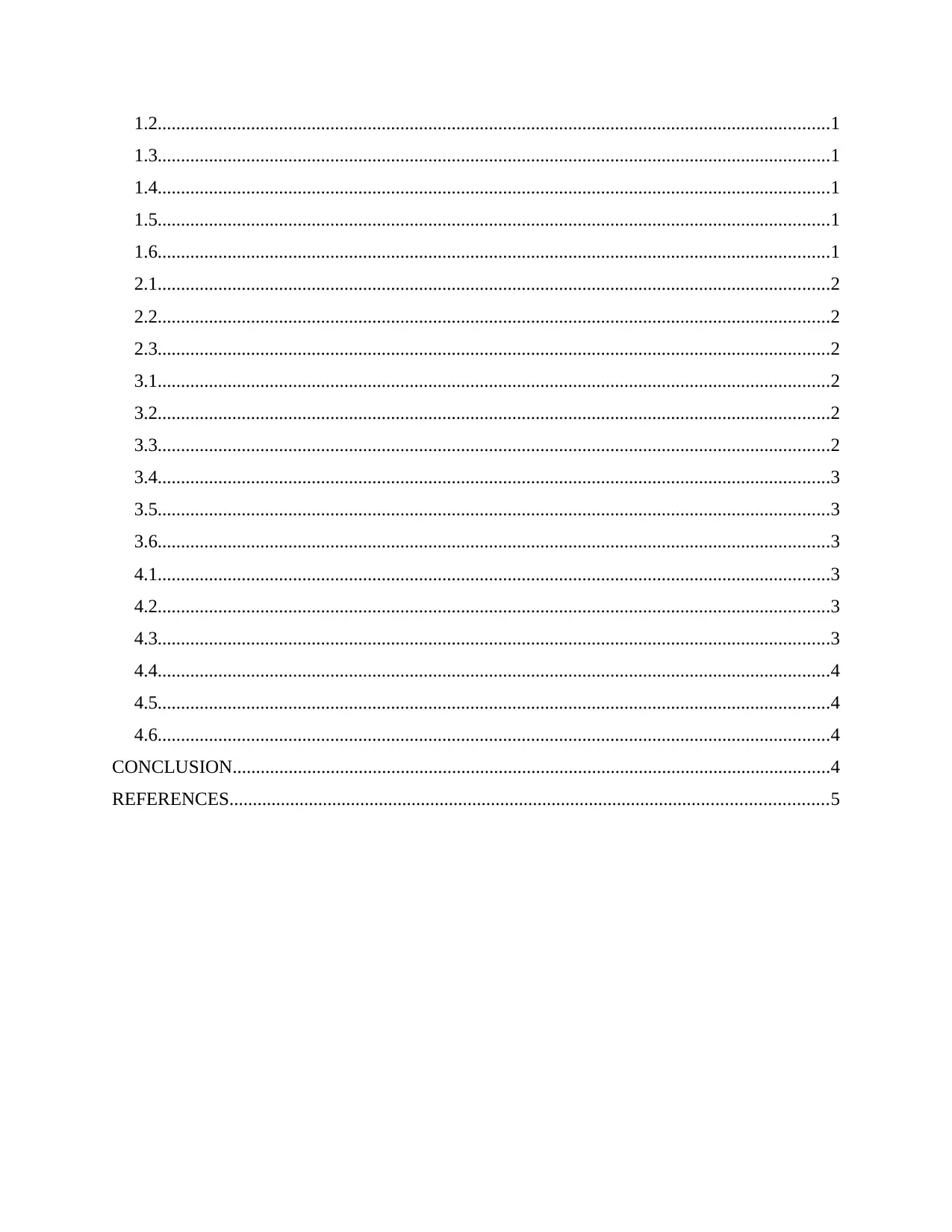
1.2................................................................................................................................................1
1.3................................................................................................................................................1
1.4................................................................................................................................................1
1.5................................................................................................................................................1
1.6................................................................................................................................................1
2.1................................................................................................................................................2
2.2................................................................................................................................................2
2.3................................................................................................................................................2
3.1................................................................................................................................................2
3.2................................................................................................................................................2
3.3................................................................................................................................................2
3.4................................................................................................................................................3
3.5................................................................................................................................................3
3.6................................................................................................................................................3
4.1................................................................................................................................................3
4.2................................................................................................................................................3
4.3................................................................................................................................................3
4.4................................................................................................................................................4
4.5................................................................................................................................................4
4.6................................................................................................................................................4
CONCLUSION................................................................................................................................4
REFERENCES................................................................................................................................5
1.3................................................................................................................................................1
1.4................................................................................................................................................1
1.5................................................................................................................................................1
1.6................................................................................................................................................1
2.1................................................................................................................................................2
2.2................................................................................................................................................2
2.3................................................................................................................................................2
3.1................................................................................................................................................2
3.2................................................................................................................................................2
3.3................................................................................................................................................2
3.4................................................................................................................................................3
3.5................................................................................................................................................3
3.6................................................................................................................................................3
4.1................................................................................................................................................3
4.2................................................................................................................................................3
4.3................................................................................................................................................3
4.4................................................................................................................................................4
4.5................................................................................................................................................4
4.6................................................................................................................................................4
CONCLUSION................................................................................................................................4
REFERENCES................................................................................................................................5
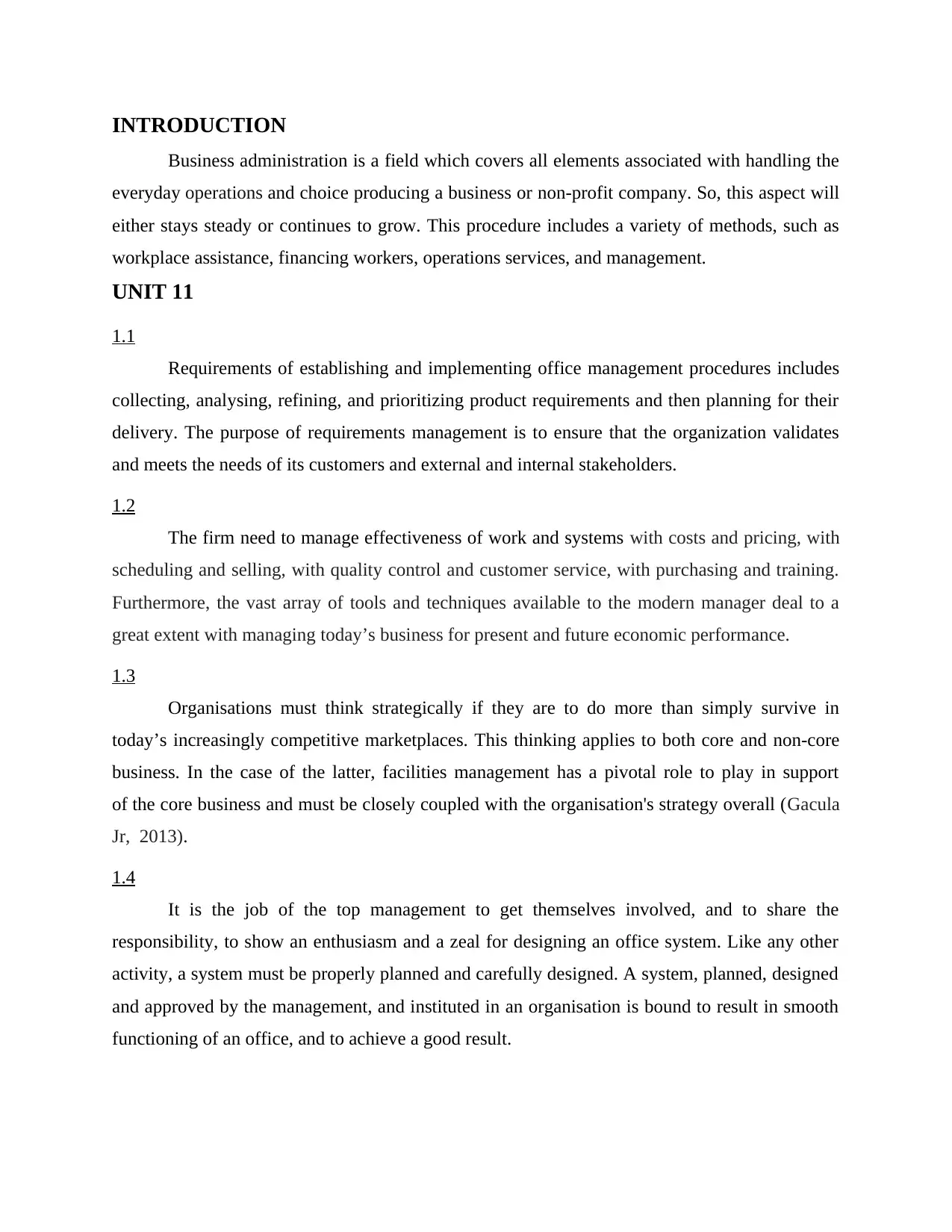
INTRODUCTION
Business administration is a field which covers all elements associated with handling the
everyday operations and choice producing a business or non-profit company. So, this aspect will
either stays steady or continues to grow. This procedure includes a variety of methods, such as
workplace assistance, financing workers, operations services, and management.
UNIT 11
1.1
Requirements of establishing and implementing office management procedures includes
collecting, analysing, refining, and prioritizing product requirements and then planning for their
delivery. The purpose of requirements management is to ensure that the organization validates
and meets the needs of its customers and external and internal stakeholders.
1.2
The firm need to manage effectiveness of work and systems with costs and pricing, with
scheduling and selling, with quality control and customer service, with purchasing and training.
Furthermore, the vast array of tools and techniques available to the modern manager deal to a
great extent with managing today’s business for present and future economic performance.
1.3
Organisations must think strategically if they are to do more than simply survive in
today’s increasingly competitive marketplaces. This thinking applies to both core and non-core
business. In the case of the latter, facilities management has a pivotal role to play in support
of the core business and must be closely coupled with the organisation's strategy overall (Gacula
Jr, 2013).
1.4
It is the job of the top management to get themselves involved, and to share the
responsibility, to show an enthusiasm and a zeal for designing an office system. Like any other
activity, a system must be properly planned and carefully designed. A system, planned, designed
and approved by the management, and instituted in an organisation is bound to result in smooth
functioning of an office, and to achieve a good result.
Business administration is a field which covers all elements associated with handling the
everyday operations and choice producing a business or non-profit company. So, this aspect will
either stays steady or continues to grow. This procedure includes a variety of methods, such as
workplace assistance, financing workers, operations services, and management.
UNIT 11
1.1
Requirements of establishing and implementing office management procedures includes
collecting, analysing, refining, and prioritizing product requirements and then planning for their
delivery. The purpose of requirements management is to ensure that the organization validates
and meets the needs of its customers and external and internal stakeholders.
1.2
The firm need to manage effectiveness of work and systems with costs and pricing, with
scheduling and selling, with quality control and customer service, with purchasing and training.
Furthermore, the vast array of tools and techniques available to the modern manager deal to a
great extent with managing today’s business for present and future economic performance.
1.3
Organisations must think strategically if they are to do more than simply survive in
today’s increasingly competitive marketplaces. This thinking applies to both core and non-core
business. In the case of the latter, facilities management has a pivotal role to play in support
of the core business and must be closely coupled with the organisation's strategy overall (Gacula
Jr, 2013).
1.4
It is the job of the top management to get themselves involved, and to share the
responsibility, to show an enthusiasm and a zeal for designing an office system. Like any other
activity, a system must be properly planned and carefully designed. A system, planned, designed
and approved by the management, and instituted in an organisation is bound to result in smooth
functioning of an office, and to achieve a good result.
⊘ This is a preview!⊘
Do you want full access?
Subscribe today to unlock all pages.

Trusted by 1+ million students worldwide
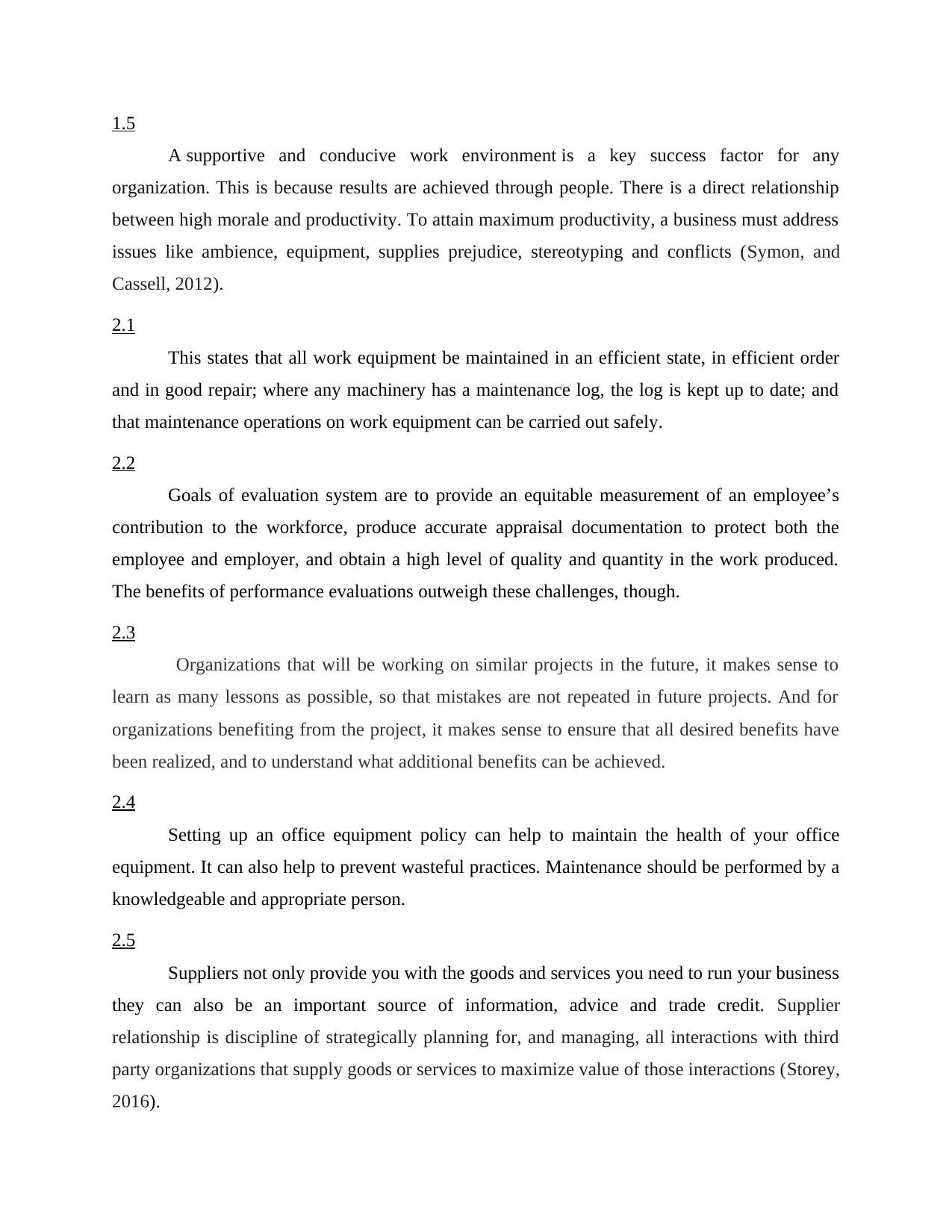
1.5
A supportive and conducive work environment is a key success factor for any
organization. This is because results are achieved through people. There is a direct relationship
between high morale and productivity. To attain maximum productivity, a business must address
issues like ambience, equipment, supplies prejudice, stereotyping and conflicts (Symon, and
Cassell, 2012).
2.1
This states that all work equipment be maintained in an efficient state, in efficient order
and in good repair; where any machinery has a maintenance log, the log is kept up to date; and
that maintenance operations on work equipment can be carried out safely.
2.2
Goals of evaluation system are to provide an equitable measurement of an employee’s
contribution to the workforce, produce accurate appraisal documentation to protect both the
employee and employer, and obtain a high level of quality and quantity in the work produced.
The benefits of performance evaluations outweigh these challenges, though.
2.3
Organizations that will be working on similar projects in the future, it makes sense to
learn as many lessons as possible, so that mistakes are not repeated in future projects. And for
organizations benefiting from the project, it makes sense to ensure that all desired benefits have
been realized, and to understand what additional benefits can be achieved.
2.4
Setting up an office equipment policy can help to maintain the health of your office
equipment. It can also help to prevent wasteful practices. Maintenance should be performed by a
knowledgeable and appropriate person.
2.5
Suppliers not only provide you with the goods and services you need to run your business
they can also be an important source of information, advice and trade credit. Supplier
relationship is discipline of strategically planning for, and managing, all interactions with third
party organizations that supply goods or services to maximize value of those interactions (Storey,
2016).
A supportive and conducive work environment is a key success factor for any
organization. This is because results are achieved through people. There is a direct relationship
between high morale and productivity. To attain maximum productivity, a business must address
issues like ambience, equipment, supplies prejudice, stereotyping and conflicts (Symon, and
Cassell, 2012).
2.1
This states that all work equipment be maintained in an efficient state, in efficient order
and in good repair; where any machinery has a maintenance log, the log is kept up to date; and
that maintenance operations on work equipment can be carried out safely.
2.2
Goals of evaluation system are to provide an equitable measurement of an employee’s
contribution to the workforce, produce accurate appraisal documentation to protect both the
employee and employer, and obtain a high level of quality and quantity in the work produced.
The benefits of performance evaluations outweigh these challenges, though.
2.3
Organizations that will be working on similar projects in the future, it makes sense to
learn as many lessons as possible, so that mistakes are not repeated in future projects. And for
organizations benefiting from the project, it makes sense to ensure that all desired benefits have
been realized, and to understand what additional benefits can be achieved.
2.4
Setting up an office equipment policy can help to maintain the health of your office
equipment. It can also help to prevent wasteful practices. Maintenance should be performed by a
knowledgeable and appropriate person.
2.5
Suppliers not only provide you with the goods and services you need to run your business
they can also be an important source of information, advice and trade credit. Supplier
relationship is discipline of strategically planning for, and managing, all interactions with third
party organizations that supply goods or services to maximize value of those interactions (Storey,
2016).
Paraphrase This Document
Need a fresh take? Get an instant paraphrase of this document with our AI Paraphraser
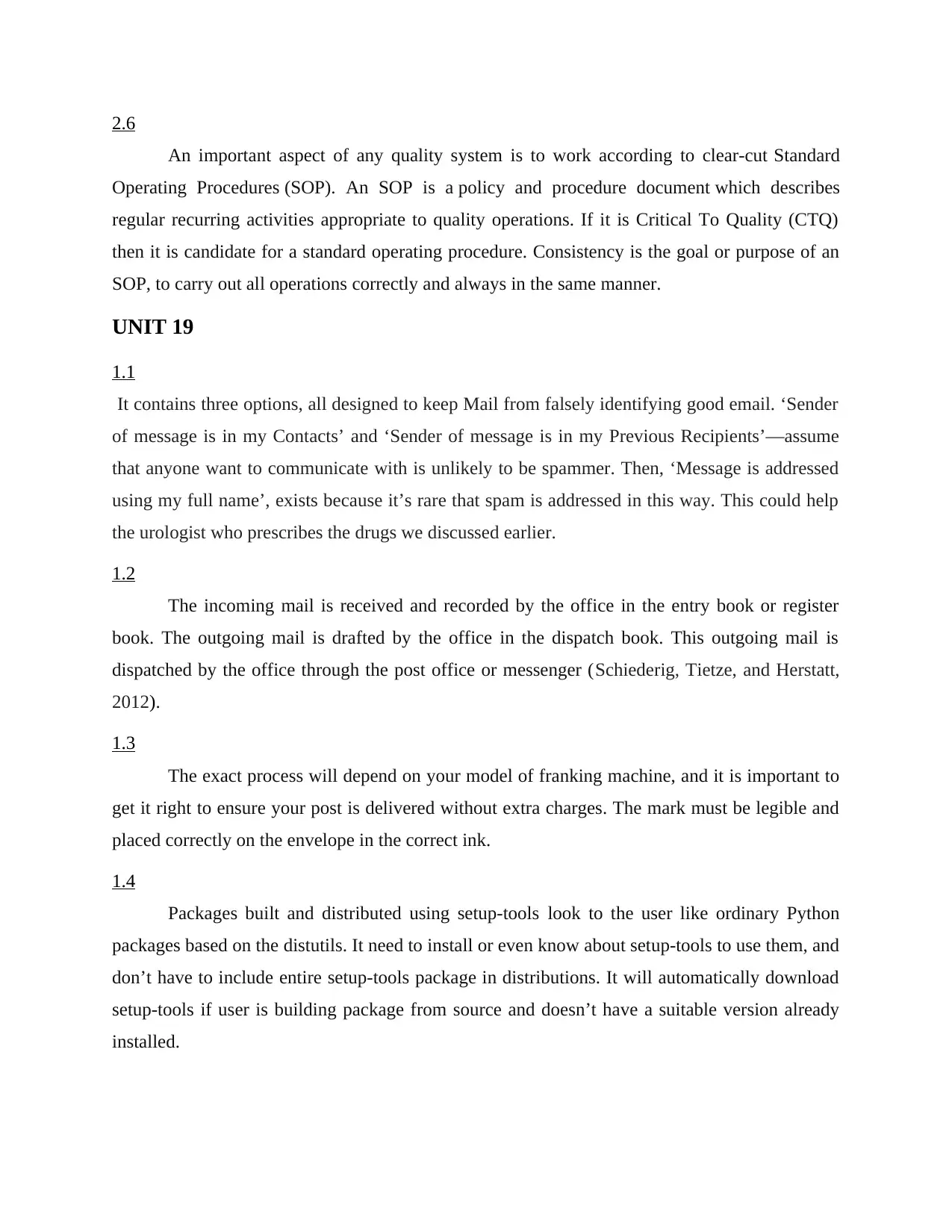
2.6
An important aspect of any quality system is to work according to clear-cut Standard
Operating Procedures (SOP). An SOP is a policy and procedure document which describes
regular recurring activities appropriate to quality operations. If it is Critical To Quality (CTQ)
then it is candidate for a standard operating procedure. Consistency is the goal or purpose of an
SOP, to carry out all operations correctly and always in the same manner.
UNIT 19
1.1
It contains three options, all designed to keep Mail from falsely identifying good email. ‘Sender
of message is in my Contacts’ and ‘Sender of message is in my Previous Recipients’—assume
that anyone want to communicate with is unlikely to be spammer. Then, ‘Message is addressed
using my full name’, exists because it’s rare that spam is addressed in this way. This could help
the urologist who prescribes the drugs we discussed earlier.
1.2
The incoming mail is received and recorded by the office in the entry book or register
book. The outgoing mail is drafted by the office in the dispatch book. This outgoing mail is
dispatched by the office through the post office or messenger (Schiederig, Tietze, and Herstatt,
2012).
1.3
The exact process will depend on your model of franking machine, and it is important to
get it right to ensure your post is delivered without extra charges. The mark must be legible and
placed correctly on the envelope in the correct ink.
1.4
Packages built and distributed using setup-tools look to the user like ordinary Python
packages based on the distutils. It need to install or even know about setup-tools to use them, and
don’t have to include entire setup-tools package in distributions. It will automatically download
setup-tools if user is building package from source and doesn’t have a suitable version already
installed.
An important aspect of any quality system is to work according to clear-cut Standard
Operating Procedures (SOP). An SOP is a policy and procedure document which describes
regular recurring activities appropriate to quality operations. If it is Critical To Quality (CTQ)
then it is candidate for a standard operating procedure. Consistency is the goal or purpose of an
SOP, to carry out all operations correctly and always in the same manner.
UNIT 19
1.1
It contains three options, all designed to keep Mail from falsely identifying good email. ‘Sender
of message is in my Contacts’ and ‘Sender of message is in my Previous Recipients’—assume
that anyone want to communicate with is unlikely to be spammer. Then, ‘Message is addressed
using my full name’, exists because it’s rare that spam is addressed in this way. This could help
the urologist who prescribes the drugs we discussed earlier.
1.2
The incoming mail is received and recorded by the office in the entry book or register
book. The outgoing mail is drafted by the office in the dispatch book. This outgoing mail is
dispatched by the office through the post office or messenger (Schiederig, Tietze, and Herstatt,
2012).
1.3
The exact process will depend on your model of franking machine, and it is important to
get it right to ensure your post is delivered without extra charges. The mark must be legible and
placed correctly on the envelope in the correct ink.
1.4
Packages built and distributed using setup-tools look to the user like ordinary Python
packages based on the distutils. It need to install or even know about setup-tools to use them, and
don’t have to include entire setup-tools package in distributions. It will automatically download
setup-tools if user is building package from source and doesn’t have a suitable version already
installed.
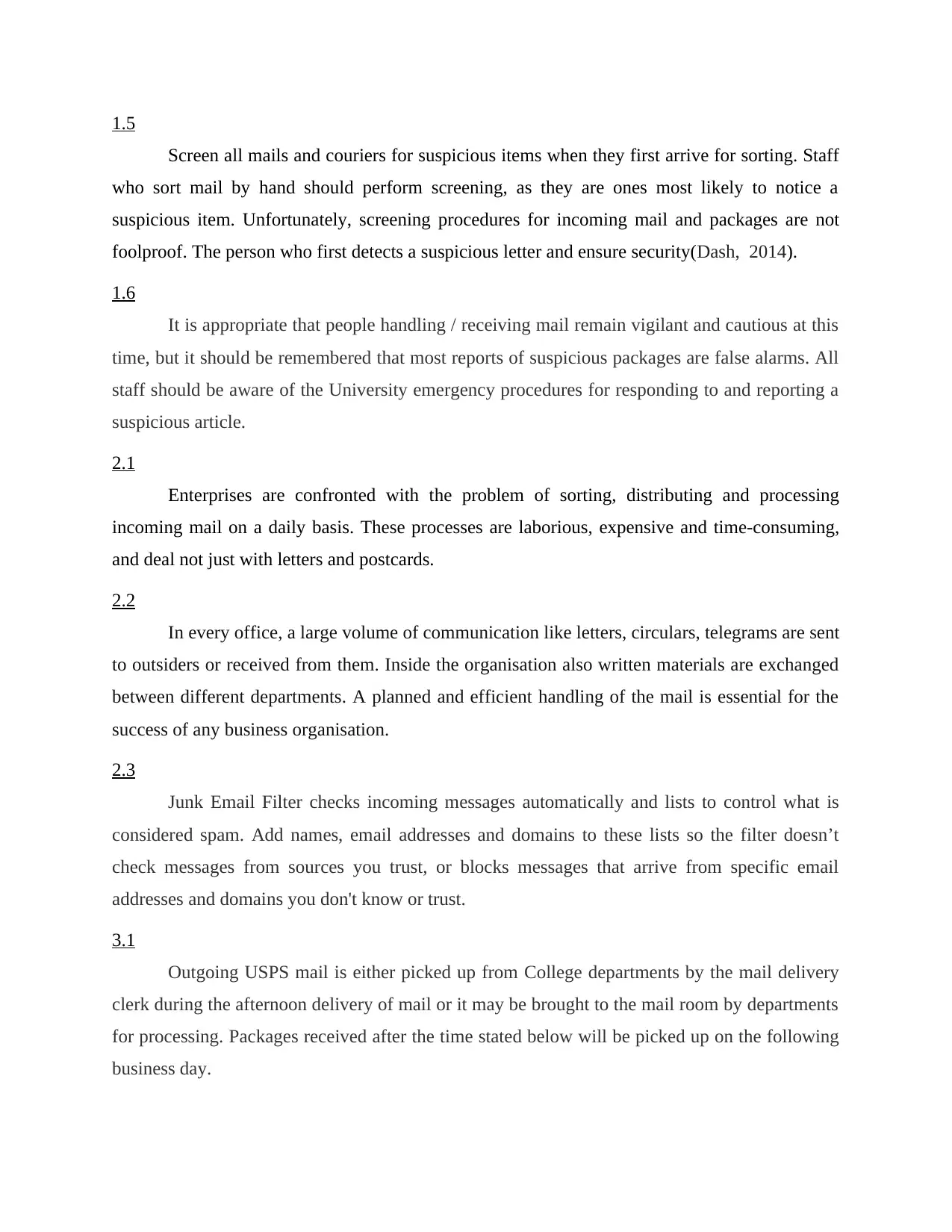
1.5
Screen all mails and couriers for suspicious items when they first arrive for sorting. Staff
who sort mail by hand should perform screening, as they are ones most likely to notice a
suspicious item. Unfortunately, screening procedures for incoming mail and packages are not
foolproof. The person who first detects a suspicious letter and ensure security(Dash, 2014).
1.6
It is appropriate that people handling / receiving mail remain vigilant and cautious at this
time, but it should be remembered that most reports of suspicious packages are false alarms. All
staff should be aware of the University emergency procedures for responding to and reporting a
suspicious article.
2.1
Enterprises are confronted with the problem of sorting, distributing and processing
incoming mail on a daily basis. These processes are laborious, expensive and time-consuming,
and deal not just with letters and postcards.
2.2
In every office, a large volume of communication like letters, circulars, telegrams are sent
to outsiders or received from them. Inside the organisation also written materials are exchanged
between different departments. A planned and efficient handling of the mail is essential for the
success of any business organisation.
2.3
Junk Email Filter checks incoming messages automatically and lists to control what is
considered spam. Add names, email addresses and domains to these lists so the filter doesn’t
check messages from sources you trust, or blocks messages that arrive from specific email
addresses and domains you don't know or trust.
3.1
Outgoing USPS mail is either picked up from College departments by the mail delivery
clerk during the afternoon delivery of mail or it may be brought to the mail room by departments
for processing. Packages received after the time stated below will be picked up on the following
business day.
Screen all mails and couriers for suspicious items when they first arrive for sorting. Staff
who sort mail by hand should perform screening, as they are ones most likely to notice a
suspicious item. Unfortunately, screening procedures for incoming mail and packages are not
foolproof. The person who first detects a suspicious letter and ensure security(Dash, 2014).
1.6
It is appropriate that people handling / receiving mail remain vigilant and cautious at this
time, but it should be remembered that most reports of suspicious packages are false alarms. All
staff should be aware of the University emergency procedures for responding to and reporting a
suspicious article.
2.1
Enterprises are confronted with the problem of sorting, distributing and processing
incoming mail on a daily basis. These processes are laborious, expensive and time-consuming,
and deal not just with letters and postcards.
2.2
In every office, a large volume of communication like letters, circulars, telegrams are sent
to outsiders or received from them. Inside the organisation also written materials are exchanged
between different departments. A planned and efficient handling of the mail is essential for the
success of any business organisation.
2.3
Junk Email Filter checks incoming messages automatically and lists to control what is
considered spam. Add names, email addresses and domains to these lists so the filter doesn’t
check messages from sources you trust, or blocks messages that arrive from specific email
addresses and domains you don't know or trust.
3.1
Outgoing USPS mail is either picked up from College departments by the mail delivery
clerk during the afternoon delivery of mail or it may be brought to the mail room by departments
for processing. Packages received after the time stated below will be picked up on the following
business day.
⊘ This is a preview!⊘
Do you want full access?
Subscribe today to unlock all pages.

Trusted by 1+ million students worldwide
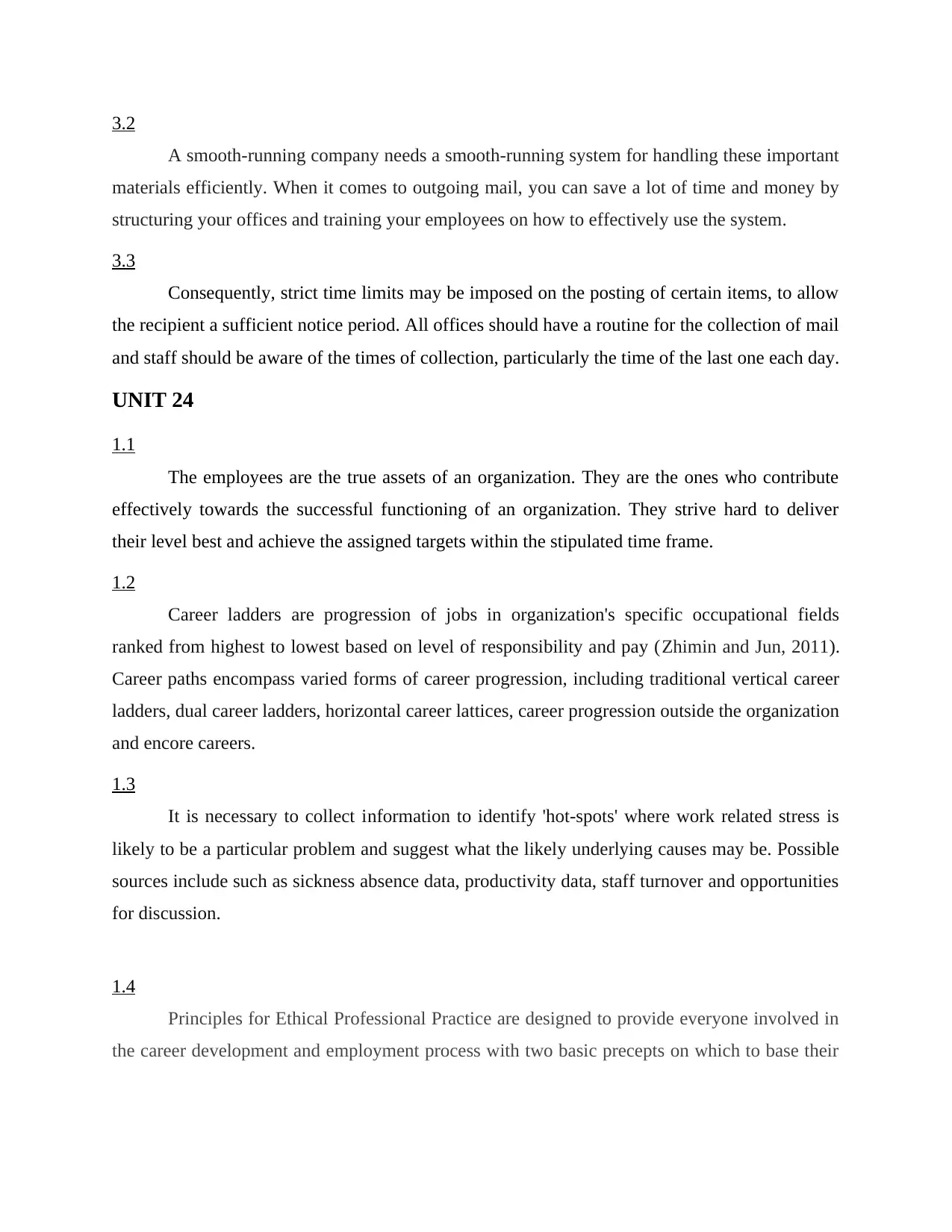
3.2
A smooth-running company needs a smooth-running system for handling these important
materials efficiently. When it comes to outgoing mail, you can save a lot of time and money by
structuring your offices and training your employees on how to effectively use the system.
3.3
Consequently, strict time limits may be imposed on the posting of certain items, to allow
the recipient a sufficient notice period. All offices should have a routine for the collection of mail
and staff should be aware of the times of collection, particularly the time of the last one each day.
UNIT 24
1.1
The employees are the true assets of an organization. They are the ones who contribute
effectively towards the successful functioning of an organization. They strive hard to deliver
their level best and achieve the assigned targets within the stipulated time frame.
1.2
Career ladders are progression of jobs in organization's specific occupational fields
ranked from highest to lowest based on level of responsibility and pay (Zhimin and Jun, 2011).
Career paths encompass varied forms of career progression, including traditional vertical career
ladders, dual career ladders, horizontal career lattices, career progression outside the organization
and encore careers.
1.3
It is necessary to collect information to identify 'hot-spots' where work related stress is
likely to be a particular problem and suggest what the likely underlying causes may be. Possible
sources include such as sickness absence data, productivity data, staff turnover and opportunities
for discussion.
1.4
Principles for Ethical Professional Practice are designed to provide everyone involved in
the career development and employment process with two basic precepts on which to base their
A smooth-running company needs a smooth-running system for handling these important
materials efficiently. When it comes to outgoing mail, you can save a lot of time and money by
structuring your offices and training your employees on how to effectively use the system.
3.3
Consequently, strict time limits may be imposed on the posting of certain items, to allow
the recipient a sufficient notice period. All offices should have a routine for the collection of mail
and staff should be aware of the times of collection, particularly the time of the last one each day.
UNIT 24
1.1
The employees are the true assets of an organization. They are the ones who contribute
effectively towards the successful functioning of an organization. They strive hard to deliver
their level best and achieve the assigned targets within the stipulated time frame.
1.2
Career ladders are progression of jobs in organization's specific occupational fields
ranked from highest to lowest based on level of responsibility and pay (Zhimin and Jun, 2011).
Career paths encompass varied forms of career progression, including traditional vertical career
ladders, dual career ladders, horizontal career lattices, career progression outside the organization
and encore careers.
1.3
It is necessary to collect information to identify 'hot-spots' where work related stress is
likely to be a particular problem and suggest what the likely underlying causes may be. Possible
sources include such as sickness absence data, productivity data, staff turnover and opportunities
for discussion.
1.4
Principles for Ethical Professional Practice are designed to provide everyone involved in
the career development and employment process with two basic precepts on which to base their
Paraphrase This Document
Need a fresh take? Get an instant paraphrase of this document with our AI Paraphraser
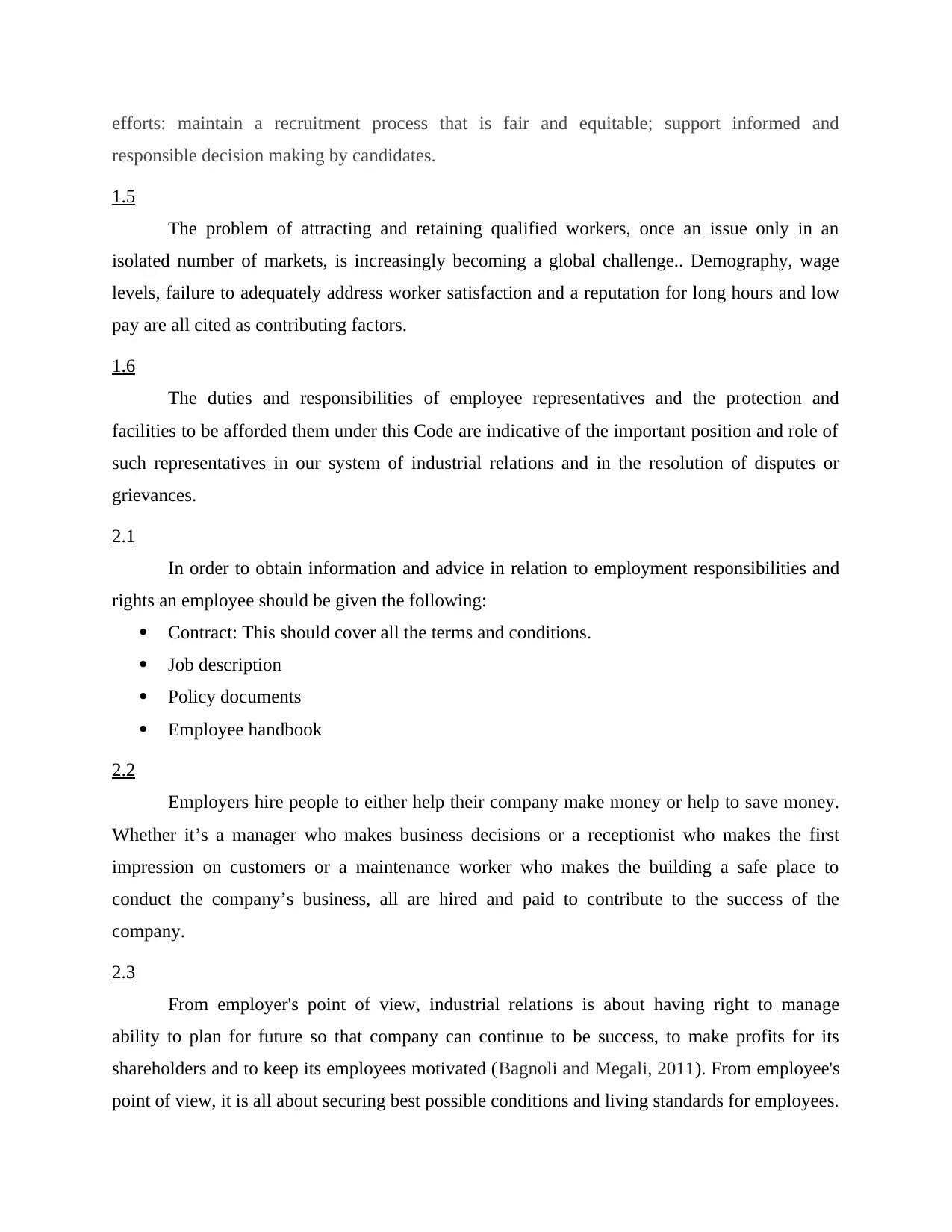
efforts: maintain a recruitment process that is fair and equitable; support informed and
responsible decision making by candidates.
1.5
The problem of attracting and retaining qualified workers, once an issue only in an
isolated number of markets, is increasingly becoming a global challenge.. Demography, wage
levels, failure to adequately address worker satisfaction and a reputation for long hours and low
pay are all cited as contributing factors.
1.6
The duties and responsibilities of employee representatives and the protection and
facilities to be afforded them under this Code are indicative of the important position and role of
such representatives in our system of industrial relations and in the resolution of disputes or
grievances.
2.1
In order to obtain information and advice in relation to employment responsibilities and
rights an employee should be given the following:
Contract: This should cover all the terms and conditions.
Job description
Policy documents
Employee handbook
2.2
Employers hire people to either help their company make money or help to save money.
Whether it’s a manager who makes business decisions or a receptionist who makes the first
impression on customers or a maintenance worker who makes the building a safe place to
conduct the company’s business, all are hired and paid to contribute to the success of the
company.
2.3
From employer's point of view, industrial relations is about having right to manage
ability to plan for future so that company can continue to be success, to make profits for its
shareholders and to keep its employees motivated (Bagnoli and Megali, 2011). From employee's
point of view, it is all about securing best possible conditions and living standards for employees.
responsible decision making by candidates.
1.5
The problem of attracting and retaining qualified workers, once an issue only in an
isolated number of markets, is increasingly becoming a global challenge.. Demography, wage
levels, failure to adequately address worker satisfaction and a reputation for long hours and low
pay are all cited as contributing factors.
1.6
The duties and responsibilities of employee representatives and the protection and
facilities to be afforded them under this Code are indicative of the important position and role of
such representatives in our system of industrial relations and in the resolution of disputes or
grievances.
2.1
In order to obtain information and advice in relation to employment responsibilities and
rights an employee should be given the following:
Contract: This should cover all the terms and conditions.
Job description
Policy documents
Employee handbook
2.2
Employers hire people to either help their company make money or help to save money.
Whether it’s a manager who makes business decisions or a receptionist who makes the first
impression on customers or a maintenance worker who makes the building a safe place to
conduct the company’s business, all are hired and paid to contribute to the success of the
company.
2.3
From employer's point of view, industrial relations is about having right to manage
ability to plan for future so that company can continue to be success, to make profits for its
shareholders and to keep its employees motivated (Bagnoli and Megali, 2011). From employee's
point of view, it is all about securing best possible conditions and living standards for employees.
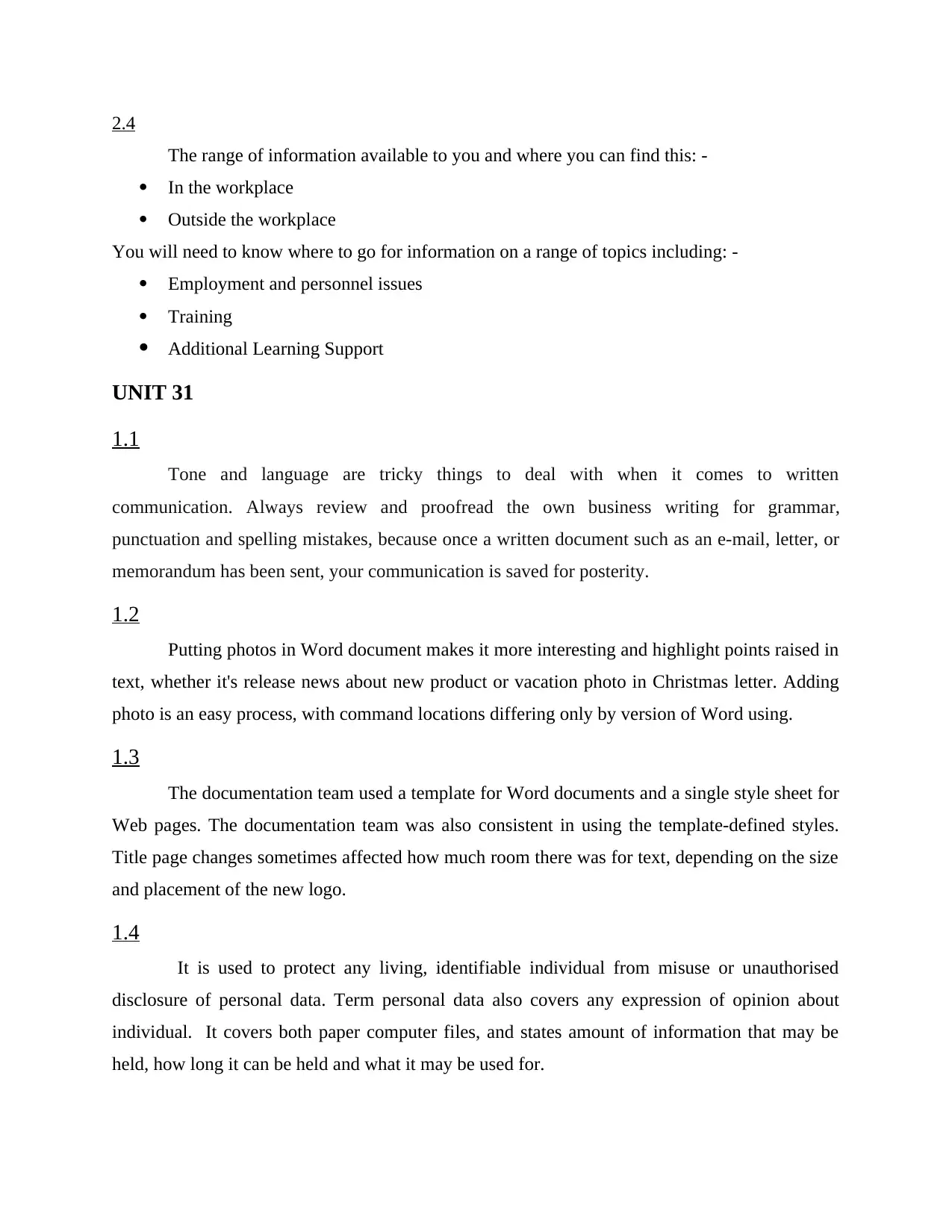
2.4
The range of information available to you and where you can find this: -
In the workplace
Outside the workplace
You will need to know where to go for information on a range of topics including: -
Employment and personnel issues
Training
Additional Learning Support
UNIT 31
1.1
Tone and language are tricky things to deal with when it comes to written
communication. Always review and proofread the own business writing for grammar,
punctuation and spelling mistakes, because once a written document such as an e-mail, letter, or
memorandum has been sent, your communication is saved for posterity.
1.2
Putting photos in Word document makes it more interesting and highlight points raised in
text, whether it's release news about new product or vacation photo in Christmas letter. Adding
photo is an easy process, with command locations differing only by version of Word using.
1.3
The documentation team used a template for Word documents and a single style sheet for
Web pages. The documentation team was also consistent in using the template-defined styles.
Title page changes sometimes affected how much room there was for text, depending on the size
and placement of the new logo.
1.4
It is used to protect any living, identifiable individual from misuse or unauthorised
disclosure of personal data. Term personal data also covers any expression of opinion about
individual. It covers both paper computer files, and states amount of information that may be
held, how long it can be held and what it may be used for.
The range of information available to you and where you can find this: -
In the workplace
Outside the workplace
You will need to know where to go for information on a range of topics including: -
Employment and personnel issues
Training
Additional Learning Support
UNIT 31
1.1
Tone and language are tricky things to deal with when it comes to written
communication. Always review and proofread the own business writing for grammar,
punctuation and spelling mistakes, because once a written document such as an e-mail, letter, or
memorandum has been sent, your communication is saved for posterity.
1.2
Putting photos in Word document makes it more interesting and highlight points raised in
text, whether it's release news about new product or vacation photo in Christmas letter. Adding
photo is an easy process, with command locations differing only by version of Word using.
1.3
The documentation team used a template for Word documents and a single style sheet for
Web pages. The documentation team was also consistent in using the template-defined styles.
Title page changes sometimes affected how much room there was for text, depending on the size
and placement of the new logo.
1.4
It is used to protect any living, identifiable individual from misuse or unauthorised
disclosure of personal data. Term personal data also covers any expression of opinion about
individual. It covers both paper computer files, and states amount of information that may be
held, how long it can be held and what it may be used for.
⊘ This is a preview!⊘
Do you want full access?
Subscribe today to unlock all pages.

Trusted by 1+ million students worldwide
1 out of 26
Related Documents
Your All-in-One AI-Powered Toolkit for Academic Success.
+13062052269
info@desklib.com
Available 24*7 on WhatsApp / Email
![[object Object]](/_next/static/media/star-bottom.7253800d.svg)
Unlock your academic potential
Copyright © 2020–2025 A2Z Services. All Rights Reserved. Developed and managed by ZUCOL.





